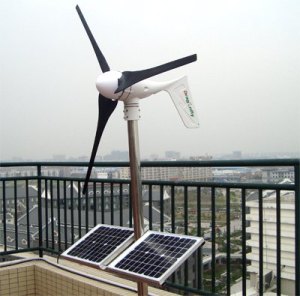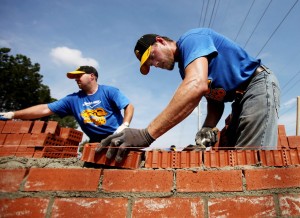[Ed. note] This was an article that I had try for several years to get published and after thinking about it last night, some of the issues started to click for me and I am glad that I was able to put down some material on sheet of paper. Texts that are italicised are new addition to the original article.
Geothermal – only a limited number of people in the Americas have heard of geothermal energy, or at least the steps required to harness this type of energy. Folks in the Norwegian countries have been using geothermal for years and the process is well understood for them. Using the delta-T (∆) of the temperature >=6′ (1.83m) below grade, a heat exchanger is able to provide suitable temperature control to indoor spaces. Of three power generation methods discussed here, this one does not generate electricity but instead provide heating and cooling using heat flow. I have some design experience with this and the system tends to be more user-friendly from a residential standpoint. Commercial and institutional application have sometimes run into issues with heat sink creation which is detrimental to the surrounding vegetation and wildlife. The ROI on this system is good and because the source & the consumption location are frequently the same, the losses experienced on the system is low. I know that some northern Canada residents have bought into this and have reaped benefits because they are able to downsize their electric/gas/oil heating components of their homes. One limitation I have encountered in the past is the inability for multiple systems to coexist in a neighbouring area, ground heating or cooling require a recovery area before the system can be efficiently utilized again and this prevents a widespread usage in an urban environment.
Wind Power – everyone’s heard of it, we feel it and those of  us who bike hate wind but really it is one of the oldest forms of renewable energies. From an engineering standpoint, as wind loads for every wind farm will vary, every wind farm will have to have specific design parameters that takes into consideration the terrain. The footage that is required in order to generate appreciable level of power is large and bigger than the other systems that I want to talk about today. In addition, I believe that in order to maximize efficiency there has to be certain spacing that the turbines will have to follow, i.e., they can’t be all jammed in together and the spacing allows wind to return to its undisturbed speeds. Most shocking to me, and I am surprised every time a professional tells me this, is that power generation is not infinite – it does increase exponentially but at certain point the turbine has to be shut off to prevent damage to the blades. There have been improvements to the design, rather than the propeller design–or horizontal axis generators–we have now vertical axis generators that takes up less footage and can be packed in tighter. Since a turbine has to be located outside of city limits (for undisturbed wind speeds and required footage), there is now the problem of transmission to the grid and capacitors are required in order to make this happen. Aesthetically and socially, it is highly visible for people to see and people who live within the municipality where these are installed can feel good about their sustainability efforts.
us who bike hate wind but really it is one of the oldest forms of renewable energies. From an engineering standpoint, as wind loads for every wind farm will vary, every wind farm will have to have specific design parameters that takes into consideration the terrain. The footage that is required in order to generate appreciable level of power is large and bigger than the other systems that I want to talk about today. In addition, I believe that in order to maximize efficiency there has to be certain spacing that the turbines will have to follow, i.e., they can’t be all jammed in together and the spacing allows wind to return to its undisturbed speeds. Most shocking to me, and I am surprised every time a professional tells me this, is that power generation is not infinite – it does increase exponentially but at certain point the turbine has to be shut off to prevent damage to the blades. There have been improvements to the design, rather than the propeller design–or horizontal axis generators–we have now vertical axis generators that takes up less footage and can be packed in tighter. Since a turbine has to be located outside of city limits (for undisturbed wind speeds and required footage), there is now the problem of transmission to the grid and capacitors are required in order to make this happen. Aesthetically and socially, it is highly visible for people to see and people who live within the municipality where these are installed can feel good about their sustainability efforts.
Solar power – in recent years, the technology behind solar panels have improved leaps and bounds. Better manufacturing of the individual solar cells gives bet ter efficiency when converting sunlight to electricity, a greater assortment of models gives customers more choices and commercialization of hybrid types of solar power like PVT allows techies to get in on the renewable energy topic by allowing customization and monitoring. However, solar power, in my opinion still gets the short end of the stick. I don’t know if it’s because we grew up watching silly solar cars go across Australia, there seems to be a great hesitation to employ solar power options beyond solar timepieces and PV panels powering the computer that’s controlling the wind turbines. The issue that has plagued PV panels seems to be how to clean them and maintain their efficiency. The cells’ ability to convert solar radiation into electricity is dependent on the cleanliness of the panels and while it’s easy to wipe down the panels on a solar car, panels on a building may not be cleaned as readily. This goes to the topic I discussed previously about LEED buildings’ reserve fund and building management. I am convinced that solar power can only catch on when people accepts panels as a common type of building cladding.
ter efficiency when converting sunlight to electricity, a greater assortment of models gives customers more choices and commercialization of hybrid types of solar power like PVT allows techies to get in on the renewable energy topic by allowing customization and monitoring. However, solar power, in my opinion still gets the short end of the stick. I don’t know if it’s because we grew up watching silly solar cars go across Australia, there seems to be a great hesitation to employ solar power options beyond solar timepieces and PV panels powering the computer that’s controlling the wind turbines. The issue that has plagued PV panels seems to be how to clean them and maintain their efficiency. The cells’ ability to convert solar radiation into electricity is dependent on the cleanliness of the panels and while it’s easy to wipe down the panels on a solar car, panels on a building may not be cleaned as readily. This goes to the topic I discussed previously about LEED buildings’ reserve fund and building management. I am convinced that solar power can only catch on when people accepts panels as a common type of building cladding.
As always, I would love to hear any of your comments on this and previous articles.

 As with many of my posts, this one came from a conversation I had with a colleague of mine. I had just saw a new building science product that combined an air/vapour barrier membrane adhered to a rigid exterior cement board. This product would be prepared in the factory. The idea behind this, and I am sure quite it’s the same for a few other products, is to take the “guesswork” out of construction and to make sure there are more safeguards site supervision isn’t the only thing standing in the way of a good job and a bad one.
As with many of my posts, this one came from a conversation I had with a colleague of mine. I had just saw a new building science product that combined an air/vapour barrier membrane adhered to a rigid exterior cement board. This product would be prepared in the factory. The idea behind this, and I am sure quite it’s the same for a few other products, is to take the “guesswork” out of construction and to make sure there are more safeguards site supervision isn’t the only thing standing in the way of a good job and a bad one.
